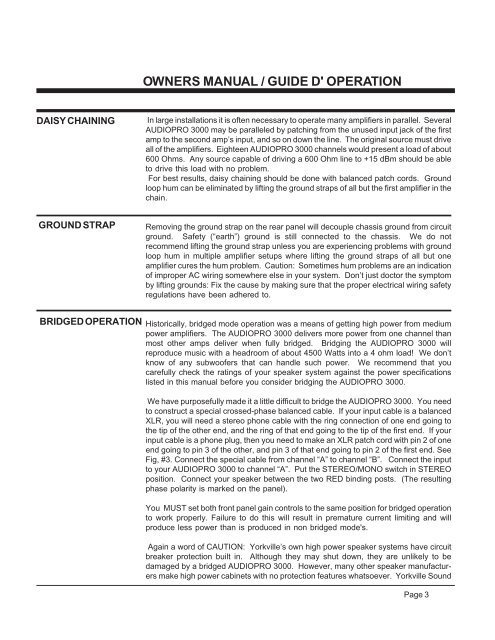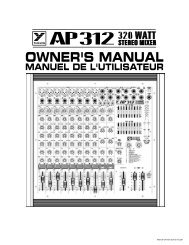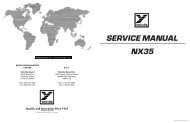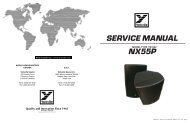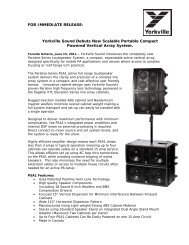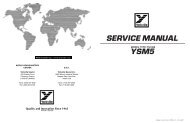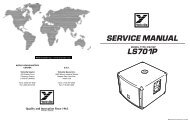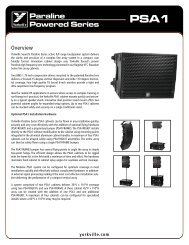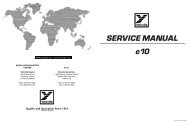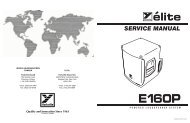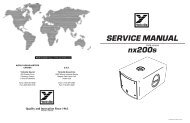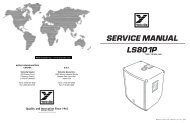owners manual / guide d' operation - Yorkville Sound
owners manual / guide d' operation - Yorkville Sound
owners manual / guide d' operation - Yorkville Sound
Create successful ePaper yourself
Turn your PDF publications into a flip-book with our unique Google optimized e-Paper software.
DAISY CHAINING<br />
GROUND STRAP<br />
BRIDGED OPERATION<br />
OWNERS MANUAL / GUIDE D' OPERATION<br />
In large installations it is often necessary to operate many amplifiers in parallel. Several<br />
AUDIOPRO 3000 may be paralleled by patching from the unused input jack of the first<br />
amp to the second amp’s input, and so on down the line. The original source must drive<br />
all of the amplifiers. Eighteen AUDIOPRO 3000 channels would present a load of about<br />
600 Ohms. Any source capable of driving a 600 Ohm line to +15 dBm should be able<br />
to drive this load with no problem.<br />
For best results, daisy chaining should be done with balanced patch cords. Ground<br />
loop hum can be eliminated by lifting the ground straps of all but the first amplifier in the<br />
chain.<br />
Removing the ground strap on the rear panel will decouple chassis ground from circuit<br />
ground. Safety (“earth”) ground is still connected to the chassis. We do not<br />
recommend lifting the ground strap unless you are experiencing problems with ground<br />
loop hum in multiple amplifier setups where lifting the ground straps of all but one<br />
amplifier cures the hum problem. Caution: Sometimes hum problems are an indication<br />
of improper AC wiring somewhere else in your system. Don’t just doctor the symptom<br />
by lifting grounds: Fix the cause by making sure that the proper electrical wiring safety<br />
regulations have been adhered to.<br />
Historically, bridged mode <strong>operation</strong> was a means of getting high power from medium<br />
power amplifiers. The AUDIOPRO 3000 delivers more power from one channel than<br />
most other amps deliver when fully bridged. Bridging the AUDIOPRO 3000 will<br />
reproduce music with a headroom of about 4500 Watts into a 4 ohm load! We don’t<br />
know of any subwoofers that can handle such power. We recommend that you<br />
carefully check the ratings of your speaker system against the power specifications<br />
listed in this <strong>manual</strong> before you consider bridging the AUDIOPRO 3000.<br />
We have purposefully made it a little difficult to bridge the AUDIOPRO 3000. You need<br />
to construct a special crossed-phase balanced cable. If your input cable is a balanced<br />
XLR, you will need a stereo phone cable with the ring connection of one end going to<br />
the tip of the other end, and the ring of that end going to the tip of the first end. If your<br />
input cable is a phone plug, then you need to make an XLR patch cord with pin 2 of one<br />
end going to pin 3 of the other, and pin 3 of that end going to pin 2 of the first end. See<br />
Fig, #3. Connect the special cable from channel “A” to channel “B”. Connect the input<br />
to your AUDIOPRO 3000 to channel “A”. Put the STEREO/MONO switch in STEREO<br />
position. Connect your speaker between the two RED binding posts. (The resulting<br />
phase polarity is marked on the panel).<br />
You MUST set both front panel gain controls to the same position for bridged <strong>operation</strong><br />
to work properly. Failure to do this will result in premature current limiting and will<br />
produce less power than is produced in non bridged mode's.<br />
Again a word of CAUTION: <strong>Yorkville</strong>’s own high power speaker systems have circuit<br />
breaker protection built in. Although they may shut down, they are unlikely to be<br />
damaged by a bridged AUDIOPRO 3000. However, many other speaker manufacturers<br />
make high power cabinets with no protection features whatsoever. <strong>Yorkville</strong> <strong>Sound</strong><br />
Page 3


